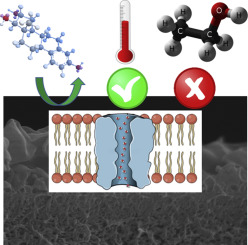Water Research ( IF 11.4 ) Pub Date : 2017-12-28 , DOI: 10.1016/j.watres.2017.12.072 Ming Xie , Wenhai Luo , Hao Guo , Long D. Nghiem , Chuyang Y. Tang , Stephen R. Gray

|
We investigated transport mechanisms of trace organic contaminants (TrOCs) through aquaporin thin-film composite membrane in forward osmosis (FO), and membrane stability under extreme conditions with respect to TrOC rejections. Morphology and surface chemistry of the aquaporin membrane were characterised to identify the incorporation of aquaporin vesicles into membrane active layer. Pore hindrance model was used to estimate aquaporin membrane pore size as well as to describe TrOC transport. TrOC transport mechanisms were revealed by varying concentration and type of draw solutions. Experimental results showed that mechanism of TrOC transport through aquaporin-embedded FO membrane was dominated by solution-diffusion mechanism. Non-ionic TrOC rejections were molecular-weight dependent, suggesting steric hindrance mechanisms. On the other hand, ionic TrOC removal was less sensitive to molecular size, indicating electrostatic interaction. TrOC transport through aquaporin membrane was also subjected to retarded forward diffusion where reverse draw solute flux could hinder the forward diffusion of feed TrOC solutes, reducing their permeation through the FO membrane. Aquaporin membrane stability was demonstrated by either heat treatment or ethanol solvent challenges. Thermal stability of the aquaporin membrane was manifested as a relatively unchanged TrOC rejection before and after the heat treatment challenge test. By contrast, ethanol solvent challenge resulted in a decrease in TrOC rejection, which was evident by the disappearance of the lipid tail of the aquaporin vesicles from infrared spectrum and a notable decrease in the membrane pore size.
中文翻译:

水通道正渗透膜对痕量有机污染物的排斥:转运机理和膜稳定性
我们研究了在正向渗透(FO)中通过水通道蛋白薄膜复合膜的痕量有机污染物(TrOCs)的传输机制,以及在极端条件下相对于TrOC排斥的膜稳定性。表征水通道蛋白膜的形态和表面化学以鉴定水通道蛋白囊泡掺入膜活性层中。孔隙障碍模型用于估计水通道蛋白膜的孔径以及描述TrOC的转运。TrOC的运输机制是通过改变汲取溶液的浓度和类型来揭示的。实验结果表明,TrOC通过水通道包埋的FO膜的传输机理主要由溶液扩散机理决定。非离子TrOC排斥是分子量依赖性的,提示了位阻机制。另一方面,离子TrOC的去除对分子大小不太敏感,表明存在静电相互作用。TrOC通过水通道蛋白膜的传输也受到延迟的正向扩散,其中反向吸取溶质通量可能会阻碍进料TrOC溶质的正向扩散,从而降低其通过FO膜的渗透。通过热处理或乙醇溶剂挑战证明了水通道蛋白膜的稳定性。在热处理挑战试验之前和之后,水通道蛋白膜的热稳定性表现为相对不变的TrOC截留率。相比之下,乙醇溶剂的刺激导致TrOC截留率的降低,这可以通过水通道蛋白囊泡的脂质尾部从红外光谱中消失以及膜孔径的显着减少来证明。










































 京公网安备 11010802027423号
京公网安备 11010802027423号